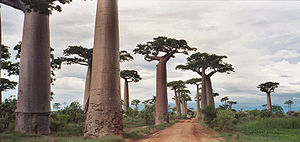Avenue of the Baobabs
| Avenue of the Baobabs | |
|---|---|
 | |
| Location | Menabe, Madagascar |
| Nearest city | Morondava |
| Coordinates | 20°15′3″S 44°25′6″E / 20.25083°S 44.41833°E |
The Avenue of the Baobabs or Alley of the Baobabs is a prominent group of baobab (Adansonia grandidieri) trees lining the dirt road between Morondava and Belon'i Tsiribihina in the Menabe region of western Madagascar. Its striking landscape draws travelers from around the world, making it one of the most visited locations in the region. It has been a center of local conservation efforts, and was granted temporary protected status in July 2007 by the Ministry of Environment, Water and Forests—the first step toward making it Madagascar's first natural monument.[1]
Along the Avenue, over some 2633 metres, are 200-250 grandidieri trees,[2] about 30 metres in height, endemic to Madagascar.[3] Another 20–25 trees of this species grow in nearby rice paddies and meadows.
Baobab trees, up to 2800 years old, known locally as renala (Malagasy for "monkey of the forest"), are a legacy of the dense tropical forests that once thrived on Madagascar. The trees did not originally tower in isolation over the sere landscape of scrub but stood in dense forest. Over the years, as the country's population grew, the forests were cleared for agriculture, leaving only the baobab trees, which the locals preserved as much for their own sake as for their value as a food source and building material.[3]
The area is not a national park, and the trees are threatened by further deforestation, effluent from encroaching rice paddies and sugarcane plantations, and bush and forest fires.[4] Despite its popularity as a tourist destination, the area has no visitor center or gate fees, and local residents receive little income from tourism. Conservation International in partnership with Fanamby, a Malagasy NGO, has launched an ecotourism project aimed at conservation of the area and economic improvement for the local community.[5]
Some 7 km to the northwest are the famous Baobab Amoureux, which are two Adansonia za trees twisted together.[6] According to the legend these two loving baobabs came and grew together across the centuries. Baobabs found themselves after an impossible love between a young man and young woman of the nearby village. Both youths already had designated partners and had to marry separately in their respective villages. However, the impossible couple dreamed of a life and child together and asked the help of their god. Both baobabs were born and now live there for eternity as one as the couple always wished.
Additional images
References
- ^ "Allée des Baobabs: Un site classé aire protégée" (in French). Madagascar Tribune. 2007-08-01. Retrieved 2008-03-22.
{{cite news}}: Italic or bold markup not allowed in:|publisher=(help) - ^ "Avenue of the Baobabs". Wondermondo.
- ^ a b Scales, Helen. "The land of the giants". Geographical (March 2007). Archived from the original on 2011-09-27.
{{cite journal}}: Unknown parameter|deadurl=ignored (|url-status=suggested) (help) - ^ "Madagascar's baobab avenue gains monumental status". Deutsche Presse-Agentur. 2007-08-14. Archived from the original on 2008-02-26. Retrieved 2008-03-22.
{{cite news}}: Unknown parameter|deadurl=ignored (|url-status=suggested) (help) - ^ Nicole Johnston (2007-08-15). "Baobab band-aid". Mail & Guardian Online. Archived from the original on 2007-10-06. Retrieved 2008-03-22.
{{cite news}}: Italic or bold markup not allowed in:|publisher=(help); Unknown parameter|deadurl=ignored (|url-status=suggested) (help) - ^ "Baobab Amoureux - baobabs in love". Wondermondo.




